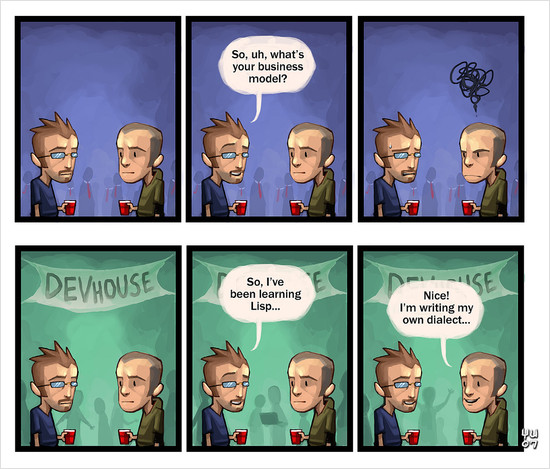January 29, 2008
Arc Released
It's finally happened: Arc's out [via gavin].
Why release it now? Because, as I suddenly realized a couple months ago, it's good enough. Even in this unfinished state, I'd rather use Arc than Scheme or Common Lisp for writing most programs. And I am a fairly representative Lisp hacker, with years of experience using both. So while Arc is not the perfect Lisp, it seems to be better for at least some kinds of programming than either of the leading alternatives.
From arclanguage.org:
the extent we can influence whatever customs are associated with Arc, we'd like to propose three principles.
Number one, expect change. Arc is still fluid and future releases are guaranteed to break all your code. In fact, it was mainly to aid the evolution of the language that we even released it.
Second, we'd like to encourage a sense of community among Arc users. If you have a question or a suggestion, share it with everyone in the forum. And if you know the answer to a question you see in the forum, help out whoever posted it by replying. Be nice; if someone's being a dick, don't let the anonymity of forums tempt you to reply in kind.
And finally: It's not a coincidence that we wrote a language for exploratory programming rather than the sort where an army of programmers builds a big, bureaucratic piece of software for a big, bureaucratic organization. Exploratory programming is the fun end of programming, and we hope that will be the guiding principle of the Arc community.
January 25, 2008
“Sleeping Is Giving In”

Me in 1988, 18 years old. Photo by Rachel (who was my prom date that year).
Maciej finally opens up about the traumatic events that led him to start The Bedbug Registry:
I discovered bedbugs and modafinil on the same eventful night a little over a year ago in San Francisco. I had just moved back from China and was staying in a dingy Travelodge on the corner of Valencia and Market streets. I had a song in my throat, a dream in my heart, and - thanks to a pharmacologically more adventurous friend - four 100mg Provigil tablets in my wallet. I was about to discover that I also had a sizable bedbug colony under my mattress.
NorthStar on a Blimp
Speaking of blimp bots and IR-based localization, Chris Anderson is actually trying to put Evolution Robotic's NorthStar system on a Jed Berk Blubber/blimp bot: “Blimp UAV: handling navigation indoors”.
He's got some pictures and discussion of the NorthStar evaluation kit.
Earlier blimp UAV posts from Chris: “Blimp UAV project: The beginning”, “Blimp UAV project: spec'ing it out”
Technology in Wartime Conference

An Israeli robot drags a critically injured Palestinian suicide bomber whose bomb exploded prematurely.
Tomorrow is the Computer Professionals for Social Responsibility (CPSR) conference “Technology in Wartime”.
This conference will explore how computer technology is used during war -- both for the purposes of combat/defense, as well as for human rights interventions into war-torn regions. Topics will include high tech weapons systems, cyberwarfare, autonomous aircraft, mobile robots, internet surveillance, anonymous communication, and privacy-enhancing technologies that aid human rights workers documenting conditions in war-torn countries and help soldiers communicate their experiences in blogs and e-mail.
Our goal will be to consider the ethical implications of wartime technologies and how these technologies are likely to affect civilization in years to come. Ultimately we want to engage a pressing question of our time: What should socially-responsible computer professionals do in a time of high tech warfare?
I wish I could go, but they say they'll be broadcasting live video.
A couple of the most interesting-looking talks:
- Ronald Arkin – Governing Lethal Behavior: Embedding Ethics in a Hybrid Deliberative/Reactive Robot Architecture [! I love hybrid deliberative/reactive robot architectures!]
- When Robots Commit War Crimes: Autonomous Weapons and Human Responsibility
Four-Pararaph Clever-Clever

“Virgin Galactic's ‘Galactic Girl’ will be carried on the spaceline's crafts. The logo is modeled after Branson's mother in her younger days.” [via est]
They are not “merely a collection of trivia”, nor is it “narrow” and “shallow”. The linklog from each of those 106 people often represents a coherent intellectual outlook and set of interests, and by following along, I learn about the particular topics they're interested in during, say, a particular week. Also, although this may not be obvious here, the pages that are usually linked are mostly not the four-paragraph clever-clever blog posts, shallow and error-ridden 500-word Reuters news releases, ten-item how-to lists, and funny YouTube videos that show up on Reddit and Digg; they are generally much more substantial information resources.
I have trouble keeping up with the 26 people in my del network.
(Kragen on Reddit: “‘merely a collection of trivia, narrow, shallow, and sensational’”; on Digg:“I know this is hard to imagine, but it's even worse than Reddit”)
January 24, 2008
Rovio: New And Improved Robotic Cat Toy

WowWee's new Rovio robot, introduced at CES, uses the NorthStar localization system developed by my old company, Evolution Robotics.
From the Evolution press release:
Las Vegas & Pasadena, Calif. (CES) – January 7, 2008 – Evolution Robotics, Inc. today announced the introduction of a major breakthrough that marks the start of a new era of "super smart" robots for the consumer market. For the first time publicly, the company unveiled its NorthStar 2.0 system, which enables robots to be truly aware of their environment and perform everyday tasks with complete autonomy. The first product to use NorthStar will be WowWee Group Limited's new Rovio™ telepresence robot, which debuts at the Consumer Electronics Show (CES) this week in Las Vegas. WowWee, an Optimal Group company is a leading designer, developer, marketer and distributor of innovative hi-tech consumer robotic and entertainment products.
NorthStar works like a combination GPS, RADAR and autopilot system rolled into one. It's designed to operate in everyday places like a home or office. So instead of showing you what exit to take on the highway, it guides your robot along a route that you establish, i.e. from your living room to a specific location in the kitchen. The system also represents a major breakthrough in price, coming in at 1/100th to 1/1000th the cost of equivalent systems used in research and industrial applications.
“These are aerospace grade technologies being introduced at consumer prices,” said Dr. Paolo Pirjanian, president and CEO of Evolution Robotics. “NorthStar will have a very profound impact on the robotics market, starting with new products in 2008 and rapidly expanding in 2009.”
The list of new products in development includes:
- a new generation of intelligent floor care robots that clean better, faster and far more efficiently than any product currently on the market
- super smart toys that interact with kids at blazingly fast speeds and bring video game action to life into the real world
- telepresence robots (such as the new WowWee Rovio robot) that allow the user to connect to the home or office while away and check if everything is ok
I wouldn't mind a NorthStar evaluation kit for my blimp bot. And the omniwheel base is pretty sexy.
Engadget has a video:
Mahalo Daily's Veronica Belmont caught up with Davin Sufer, WowWee's CTO, for an up-close look at the new WiFi-enabled Rovio bot -- and it looks pretty sweet. Users control the Rovio through any browser, and the interface includes full-motion video from the built-in camera, which can be aimed up and down to ease navigation.
Gizmodo says it's “Everything the Aibo Should Be”:
WowWee, makers of such fine products as cat-hunting dragonflies, have unveiled a new, fairly badass three-wheeling robot for home use that's not all the different from the specs we've seen in Sony's new rumored AIBO. A webcam-enabled robot featuring a Northstar GPS system, you can spy on anyone in your house from anywhere in the world.
Syncing with your PC via Wi-Fi, WowWee sees users controlling the Rovio through the internet, cellphones, and yes, even game consoles. What's really promising is that instead of just navigating through your hallways via arm-mounted webcam, you can set waypoints (aka bathrooms) within your house and send your evil minion Rovio there with the click of a button.
January 10, 2008
European Common Lisp Meeting in Amsterdam
ECLM 2008 is go:
Arthur Lemmens and Edi Weitz are proud to announce the European Common Lisp Meeting 2008. The meeting will consist of a Sunday full of talks on April 20, 2008, with optional dinners on Saturday and Sunday evening.
I see Kenny Tilton has a rant scheduled.
hCalendar test:
January 08, 2008
DIY Drones at ETech

“J-Bird and I went for lunch at Clifton's Cafeteria and Bank of America was robbed.”
Chris Anderson is doing a DIY Drones session at ETech 2008:
DIY Drones: An Open Source Hardware and Software Approach to Making “Minimum UAVs”
Today the amateur UAVs movement has moved beyond university research teams and includes hundreds of individuals around the world who are building relatively inexpensive aircraft (fixed wing and helicopters) that can fly autonomously, take pictures or videos and transmit them to the ground, follow navigational waypoints for aerial mapping and scientific surveys, and otherwise duplicate many of the functions once reserved for military UAVs that cost hundreds of thousands or millions of dollars.
This session will demonstrate the leading edge of this: some of the cheapest UAVs ever built. Some are based on LEGO Mindstorms NXT, some use regular cell phones strapped to model planes, and some use hobby-grade embedded microprocessors grafted to radio control (RC) aircraft. All are fully autonomous (automated stabilization and navigation, allowing them to fly out of eyesight and RC range) and most of them cost less than $1,000. Onboard imaging systems range from gyro-stabilized digital cameras to video systems with pan-tilt gimbals and real-time downlinks and telemetry.
Eh, too expensive.
Rainy CRACL
Winter storms and a last minute venue change meant we only had 8 people at Sunday's CRACL meeting. But we had a good time, lots of new blood, and hopefully will get together again soon.
January 03, 2008
Weinreb's Commentary on Lisp Complaints

Nuestra Señora de las Iguanas, Juchitán, Oaxaca. “This woman arrived [at the market] with iguanas on her head to sell, and I told her: ‘Wait a minute, let me take your picture.’”
Dan Weinreb, “Complaints I'm Seeing About Common Lisp” [via anachaia]:
Despite many the successful applications written in Common Lisp, many people complain about it. I’ve been looking around the web seeing what the predominant complaints are. I’ve come up with two lists of complaints: the ones that are about things inherent to Common Lisp that can’t be fixed within the context of Common Lisp, and the ones that could be addressed. With each one, I’ve added some commentary.
Also of interest, in one of the comments Dan says “I and some friends have been thinking about how to do a good CPAN-like system. We’ll talk about it when we have our act together.”
I don't know how long Dan can keep up the consistent awesomeness of his blog, but I hope it's a while.
January 02, 2008
CRACL is Back

Normal Silicon Valley party vs. SuperHappyDevHouse [via est].
CRACL, the LA Lisp enthusiasts' group, is holding its first meeting of 2008.
The next CRACL meeting is 6 pm Sunday, Jan. 6th, 2008.
We will meet at Royal Claytons pub in the Eastern downtown Los Angeles Arts District.
There will even be an extended happy hour, with $4 well drinks and $3 beer.



